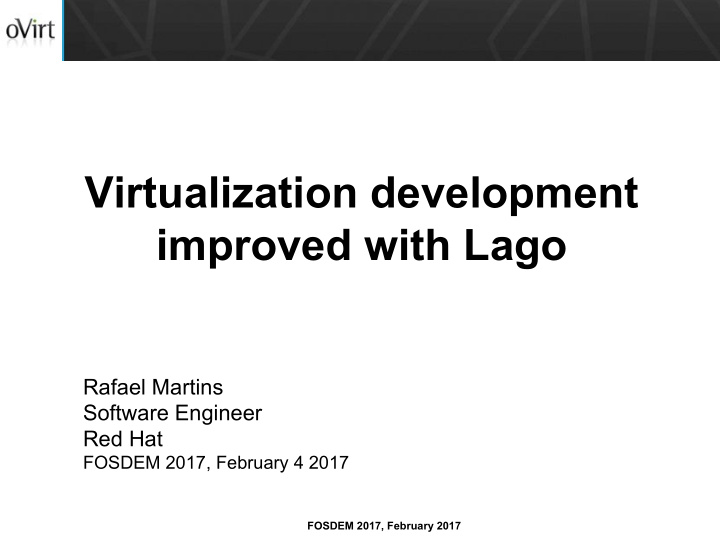



Virtualization development improved with Lago Rafael Martins Software Engineer Red Hat FOSDEM 2017, February 4 2017 FOSDEM 2017, February 2017
Description of the problem Virtualization-related products are hard to test manually and automatically FOSDEM 2017, February 2017
What is oVirt? oVirt manages virtual machines, storage and virtualized networks. oVirt is a virtualization platform with an easy-to-use web interface. oVirt is powered by the Open Source you know - KVM on Linux. FOSDEM 2017, February 2017
What is oVirt? FOSDEM 2017, February 2017
The solution? Lago Project ● Ad-hoc virtual framework which helps you build virtualized environments on your server or laptop for various use cases. ● Based on libvirt and KVM ● Easily extensible in Python, with plugin infrastructure. FOSDEM 2017, February 2017
How oVirt uses Lago oVirt support is implemented as a Lago plugin (ovirtlago), that knows how to deal with oVirt engine and hosts. ovirtlago plugin LAGO FOSDEM 2017, February 2017
oVirt System Tests oVirt System Tests Host Engine LAGO Host FOSDEM 2017, February 2017
oVirt System Tests oVirt relies on a suite of automated tests, that deploy and run several tests cases. ● Quick visibility of critical breakages. ● Well maintained set of test cases, frequently improved. ● Virtual machines are left to be used after test execution. FOSDEM 2017, February 2017
oVirt System Tests FOSDEM 2017, February 2017
What about manual testing? oVirt System Tests relies on the “ovirtlago” plugin, that supports installation of custom RPM packages. ● oVirt project provides Jenkins jobs to build RPM packages from Gerrit patches. ● A developer can build RPMs on his laptop! ● Simple patches can be verified by running the full test suite with a custom RPM. FOSDEM 2017, February 2017
What about manual testing? There are a few downsides when using oVirt System tests to run manual tests: ● Using oVirt System Tests to do manual testing requires running the full test suite. This is not always required/wanted. ● If the patch changes the behavior expected by the test suite, it needs to be adapted too. ● Sometimes the environment deployed by oVirt System tests is not suitable to verify the patch. FOSDEM 2017, February 2017
oVirt Patch Verifier Relies on Lago and the ovirtlago plugin to create test environments that are targeted to manual testing. ● Environment is defined easily on command line, when calling the plugin to deploy. ● No need to run automated test suites to get oVirt engine and hosts running. ● Can create as many oVirt hosts as wanted, and attach them to the oVirt engine automatically. FOSDEM 2017, February 2017
oVirt Patch Verifier ● $ lago opv deploy \ --vm engine,name=engine,memory=8192 \ --vm host,name=host1 \ --vm host,name=host2 \ --custom-source http://jenkins.ovirt.org/job/... ● $ lago opv engine-setup ● $ lago shell engine # engine-setup FOSDEM 2017, February 2017
oVirt Patch Verifier FOSDEM 2017, February 2017
oVirt Patch Verifier There are also some downsides on this approach: ● Fully automated, requires caching of a lot of unneeded RPMs for the internal repository, or download of dependencies for each VM. ● Can’t deploy more than one oVirt engine simultaneously. FOSDEM 2017, February 2017
Supporting other projects Lago is not tied to oVirt, so it means that it is possible to write plugins to test other projects. ● Test virtualization managers ● Test appliances ● Build virtualization environment FOSDEM 2017, February 2017
Why should I use Lago instead of ... ? Lago may be compared to other similar tools, like: ● Vagrant ● Avocado ● LAVA FOSDEM 2017, February 2017
THANK YOU! http://www.ovirt.org http://lago.readthedocs.io/ rmartins@redhat.com rafaelmartins @ GitHub, Twitter, Freenode, OFTC https://rgm.io/ FOSDEM 2017, February 2017
Recommend
More recommend